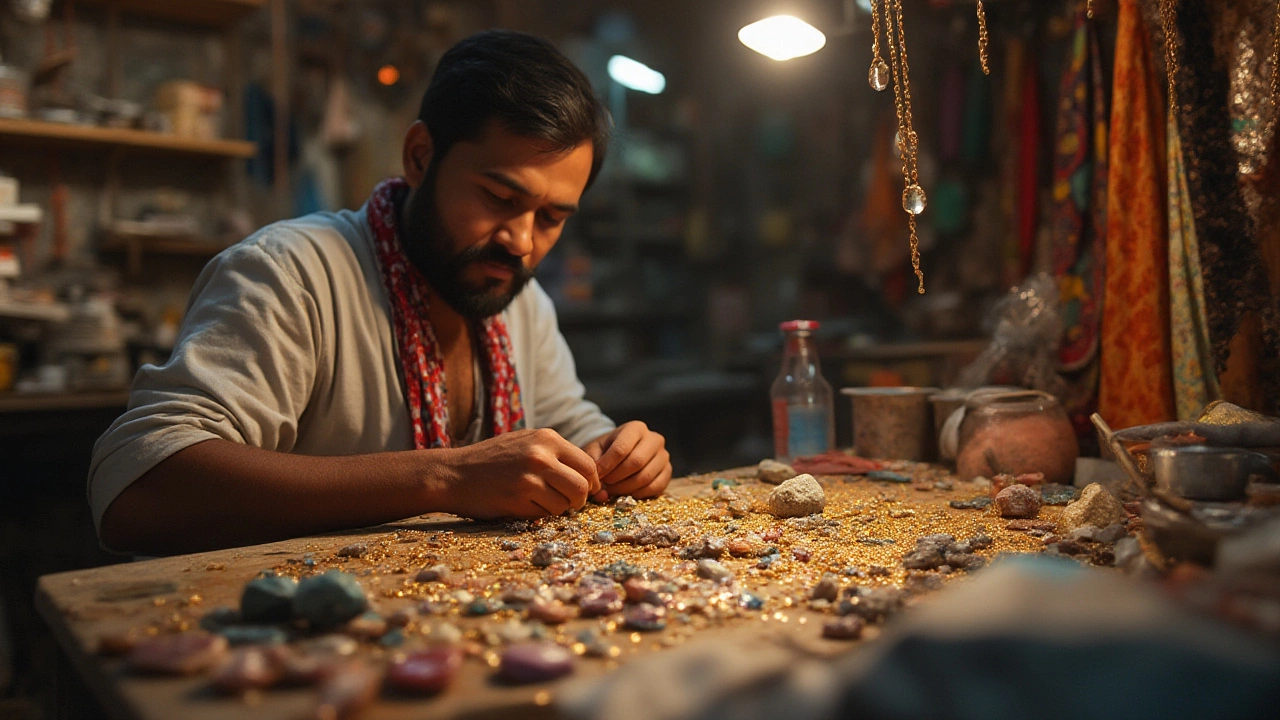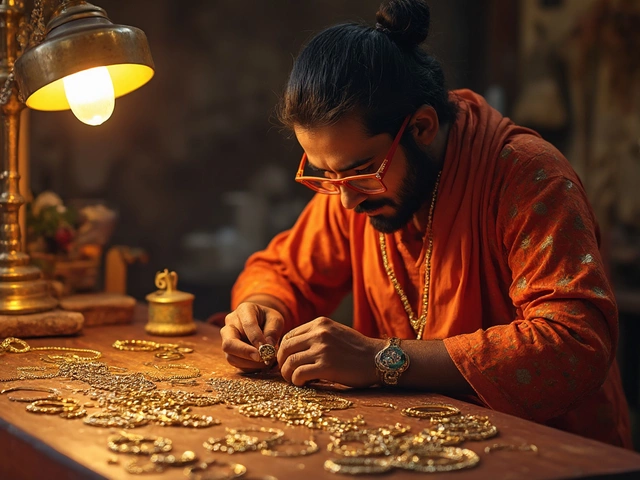
No one wakes up and stumbles into a jewelry line by accident—it takes planning, cash, guts, and usually a lot of coffee. Think of all the shiny necklaces and bold rings you see on Instagram; behind each piece is someone biting their nails over budgets and wondering if rose gold or sterling silver will bankrupt them faster. If you’re itching to carve out a spot in this shimmery world, you’ll want to know exactly what you’re getting into, dollar by dollar. Ready? Keep your calculator close—you’ll need it.
Breaking Down the Essential Startup Costs
The first thing most hopeful jewelers ask is, "How much cash do I actually need to make this work?" The answer can swing wildly—from a scrappy $500 DIY project in your kitchen to fifty grand (or more) if you’re aiming for a polished launch in the luxury lane. It’s more than beads and baubles; your costs split into a few big-picture buckets:
- Design and Prototyping: Where sketches come to life. CAD software can set you back $50/month to $300 outright, plus $100–$500 per prototype (even more if you’re working with a real jeweler or going overseas).
- Materials and Tools: Raw metals, stones, clasps, beads, plus pliers, soldering kits, a workbench—minimum $250 for basics, but real gemstone or gold work? That starts at $1,500+ easily.
- Production: Even if you’re grinding away at your own desk, count on $10–$50 per piece when doing small runs. Outsourcing or casting means anywhere from $500–$5,000 for a minimum production run, depending on complexity and materials.
- Branding and Packaging: Logo design ($100–$1000), custom packaging and boxes ($0.50 to $3 per unit), website setup ($200 for DIY, up to $5,000 for pros).
- Legal and Administrative: LLC registration, business license, insurance... These bits rarely get the spotlight but can total $500–$2,500, depending where you live.
The cheapest setup—let’s say beaded jewelry sold from an Etsy page—could live under $1,000. But let’s be honest, most brands sink $2,000–$10,000 before they get footing. According to Shopify’s 2024 industry report, "The median jewelry startup in the US spends about $3,200 before its first product reaches customers." No two stories are the same. If you’re dreaming of precious metals and gemstones, start higher. Got ambitions for high-end luxury? Add a zero.
| Expense | Low-End | Mid-Range | High-End |
|---|---|---|---|
| Design/Prototyping | $100 | $800 | $2,500 |
| Materials/Tools | $250 | $2,000 | $10,000 |
| Production (per run) | $500 | $2,500 | $15,000 |
| Branding/Packaging | $350 | $1,800 | $7,000 |
| Legal/Admin | $500 | $1,000 | $2,500 |
| Marketing | $200 | $1,500 | $8,000 |
| Total | $1,900 | $9,600 | $45,000+ |
What Drives the Cost Up (and Down)?
Ever wonder why two new brands seem to have wildly different startup stories? It’s not just luck—it’s dozens of decisions stacking up. Sourcing is a big one. If you pick gold-plated brass from a local supplier, expect totally different numbers than importing 18k gold chains from Italy. And custom gemstone cutting? That adds up fast. As one industry vet told Vogue last year, "Custom is king for branding—but a nightmare for budgets."
Production volume plays a huge role. If you start with fifty pieces, your price per necklace could hover at $30–$50. But make a thousand and suddenly, the price can fall under $10 per unit. Of course, now you’re married to hundreds of pieces you need to sell. Lots of founders start small—prototyping a few pieces, seeing what sells, then scaling up production. It cuts risk and keeps you from filling your garage with unsold earrings.
The way you sell also matters. Running a Shopify store from home is cheap. Popping up at craft or jewelry shows costs booth fees ($100–$800 per weekend), displays, transportation, and travel. Opening a boutique or getting into department stores? You’ll need inventory, retail packaging, wholesale margins, and maybe a chunk set aside for returns and chargebacks.
And don’t ignore branding. Some folks slap products online with their name in Comic Sans. Others invest in pro logos, paid photoshoots, high-gloss packaging—they look legit but spend $2,000–$10,000 before a sale. That’s not "required" but it does turn heads, especially if you want press coverage.

How to Budget Like a Pro (Even if You’re on a Shoestring)
I’ll tell you a secret: the best jewelry lines aren’t the biggest spenders—they’re the best at squeezing value from every penny. Start with the essentials. Decide how many designs to launch, set a tight budget for prototypes, and test your concept before splashing out. If you’re flying solo, learning basic design software saves a ton (Figma or Canva can get you surprisingly far). Not a pro photographer? Natural light and an iPhone plus a $25 lightbox can work magic for early photos.
Bulk-buying supplies can save you 10–30% versus retail. For gold or silver, track daily prices—they swing a lot. Sometimes just waiting out a dip can cut your costs, if you can afford to wait. And don’t underestimate the secondhand market. Maya once found a full set of professional pliers, as good as new, at a flea market for less than a third of retail. Craft supply swaps, jewelry Facebook groups, and even Reddit have become goldmines (pun intended) for serious savings.
Another tip: nail the core products before branching out. Those massive six-collection launches on social media? Most are smoke and mirrors. Start with bestsellers, get feedback, then reinvest profit into new lines. The fashion cycles are ruthless—one bad bet on a trend or mishap on sizing, and you’re stuck with dead stock or have to discount deep to move it out the door.
Don’t skip legal basics, no matter how small you start. A quick online LLC filing protects your personal savings and can often be set up for a few hundred bucks. Insurance for theft or liability is wise—it’s rare, but one broken clasp on a premium necklace can lead to a huge headache. Software for accounting (think QuickBooks or Wave) keeps you from scrambling at tax time. Setting these up early is way easier than fixing a mess when you’re already swamped with orders.
Getting Your First Sales: Marketing and Hidden Costs
This is where most first-timers stumble: hidden expenses creep up fast. You can build the prettiest pendant in the world, but unless you get eyeballs on it, all those hours and dollars might as well be sunk in quicksand. Social media advertising has become a must, but it can chew through budgets. Even a modest Instagram campaign can eat $150–$500 a month with mixed results. Influencer promotions? The going rate ranges from a free pair of earrings for "micro-influencers" to $2,500 for folks with real reach.
Don’t ignore "free" marketing, though. Good product shots, a tight brand story, and engaging with potential customers on TikTok or Instagram still work. Press outreach is cheap—but results are hit-or-miss. As Fast Company wrote last spring:
"The brands that stick are the ones that make noise, not just products."If you can, start collecting contacts for an email list (Mailchimp and similar services are free to start up to 2,000 contacts).
Events and pop-ups are another expense. There’s the entry fee, sure—but then add tablecloths, promotional signs, samples, travel. I’ve seen people spend $700 on their first event before selling a single piece. Sometimes you break even. Sometimes you strike gold—one friend landed a wholesale order from a boutique owner who just happened to wander by. Be ready for both scenarios.
Plan for returns and warranty issues. Even the most careful maker can have a clasp fail, or a customer change their mind. Etsy and Shopify both show high return rates for jewelry, often 8%–12%, so stash some cash away for fixes or refunds. Shipping isn’t just a stamp and a box—insurance, tracking, and upgraded packaging add up (roughly $3–$7 each, depending on item weight and distance).

Are There Ways to Cut Corners Without Cutting Quality?
Absolutely. The trick is to find where spending actually brings returns, and where it’s just vanity. For example—do you need a $5,000 custom brand video upfront? Probably not. Even some high-profile jewelry startups shot their first marketing clips on smartphones. But don’t skimp on good clasps or tarnish-resistant plating; one bad review about "cheap materials" can do more harm than any glossy commercial can fix.
- Start with limited runs: Instead of launching with hundreds of pieces, try a pre-order model to gauge interest. Manufacture only what’s sold in advance—minimizing risk and upfront costs.
- Lean on community: Jewelry schools, online groups, even established local makers will sometimes partner or share tips if you ask nicely (and offer value back).
- DIY what you can: Package labels, jewelry cards, even simple logos can be knocked out with Canva or Vistaprint for less than professional rates (but don’t plagiarize—your brand should be your own!).
Don’t obsess over slick perfection at the outset. Customers will forgive rough edges if your designs are strong and you’re authentic. Polish and professionalism matter, but they grow as your business and confidence do.
My advice—focus on nailing your cost to start jewelry line numbers. Don’t be scared to ask for help, and don’t rush the branding decisions. If you do things right, your first $2,000–$10,000 will be the start of something that could outshine even your wildest dreams. So set your budget, get creative, and make that jewelry line shimmer without breaking the bank.


